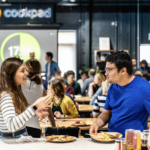 Feeling like we belong at work is something many of us crave, yet most of us lack. Indeed, 40% of employees state that they often feel isolated at work, which results not only in lower engagement levels but also less commitment to the organization.
Feeling like we belong at work is something many of us crave, yet most of us lack. Indeed, 40% of employees state that they often feel isolated at work, which results not only in lower engagement levels but also less commitment to the organization.
A few years ago the Guardian asked readers to write in with their tales of isolation at work, and several hundred did so, with many lamenting the lack of any real sense of belonging at work. It’s a problem encapsulated by data from the people experience company BetterUp, which shows how our sense of belonging is closely linked to the social connections we have at work, with our sense of identification, and that we, and our work, matter. There is a clear desire to feel accepted and included by those we work with.
Eating together
In The Social Brain, Robin Dunbar outlines how food has historically played a crucial role in this bonding process. While food in many workplaces is something consumed as quickly as possible at one’s desk, it has traditionally been a means of welcoming strangers into a community.
During the pandemic, this is something that took off around the world, with people taking cooking experiences with those from different cultures. For instance, I recently participated in “Pasta with the Grandmas”, an online Zoom class whereby one learns to cook one of a range of traditional Italian dishes under the expert tuition of Nonna Nerina and her granddaughter Chiara, from Palombara Sabina, Italy.
“Six years ago, Nonna Nerina started to make pasta in front of me and she was telling me about her mother, her grandma, and the community of women in the town,” Chiara tells me. “Through food, I learned about their lives and how I was part of a much bigger story. In the past six years, we’ve opened up not only our own house but that of a lot of grandmas in Palombara to thousands of travelers to help them feel what I felt.”
Bringing people together
The business has grown to feature around 20 grandmas from across the village, each of whom provides their own special recipes and family history to tap into. Each class is accompanied by a video showcasing the area and a unique insight into regional life that leaves you feeling very much a part of the community.
This use of food to bring people together is also fundamental to the success of the Japanese recipe-sharing website Cookpad, which encourages staff to not only eat together but to cook and prepare meals together.
“Food connects us all and cooking is intrinsic to our very being. When we enjoy a home-cooked meal with family and friends, it has a positive impact on ourselves, our community and the environment,” Rimpei Iwata, President and CEO of Cookpad, told me. “The power of cooking and eating together is universal in connecting people, which is why we offer a fully-stocked Cookpad Kitchen in our offices, including our global HQ in Bristol (UK).”
Iwata explains that employees would often arrive early to work in order to share a cooked breakfast with their colleagues. During lunchtime, far from people eating solitary sandwiches at their desks, the kitchen area is abuzz with people from different teams and cultures preparing meals together that are then enjoyed at communal dining tables.
“We can see the important role our kitchen space has played in helping team members bond and get to know each other since the return to office working post-pandemic,” Iwata says. “In a recent survey, 93% of employees told us they feel more connected to peers thanks to the Cookpad Kitchen, and 85% feel more passionate about the company as a result of using this space.”
Physical proximity
While the pandemic meant many of us worked virtually, it also reminded us of the importance of being together physically. The Allen Curve highlights how physical proximity precipitates the likelihood that we’ll work together, and this is often because this proximity allows us to engage in informal conversations about things we might not otherwise engage in.
This is something that remote working doesn’t really facilitate, as we only come together for set-piece meetings. Indeed, on a recent demo of Meta’s latest VR headset, the same problem emerged as people only really enter the metaverse for meetings, and our avatars didn’t have the capability to freely move about and have the informal and unexpected meetings that are so crucial.
For instance, Katalin Kariko and Drew Weissman famously developed the mRNA technology that helped to power the Covid vaccines after a chance encounter at the photocopier.
Food can play a crucial role in this. For instance, Oxford philosopher Theodore Zeldin notably turned an IKEA branch in Liverpool into a cultural and educational center where strangers would strike up random conversations over an evening meal in the store’s restaurant.
The project utilized the Menu of Conversation to allow participants to discuss what mattered to them. This is a concept developed by Zeldin whereby diners are each given a menu, which instead of featuring food choices has topics of conversation, which each person is invited to pick and discuss in turn. The aim is to facilitate “big talk, not small talk.”
It’s estimated that the typical lunch break is just 30 minutes, with many choosing to skip lunch entirely. Keith Ferrazzi famously urged us to never eat alone but this is a memo many organizations have clearly not received. At a time when organizations are scrambling to attract the talent they so desperately need, perhaps food is the unheralded way to employees’ hearts.